Demonstrative Video
Second-Order Circuits
Response Cases
Overdamped Case \(\left(\alpha>\omega_{0}\right)\) when \(L>4 R^{2} C\)
The roots of the characteristic equation are real and negative
- \[\boxed{v(t)=A_{1} e^{s_{1} t}+A_{2} e^{s_{2} t}}\]The response is
Critically Damped Case \(\left(\alpha=\omega_{0}\right)\) when \(L=4 R^{2} C\)
The roots are real and equal
- \[\boxed{v(t)=\left(A_{1}+A_{2} t\right) e^{-\alpha t}}\]Response:
Underdamped Case \(\left(\alpha<\omega_{0}\right)\) when \(L<4 R^{2} C\)
- \[s_{1,2}=-\alpha \pm j \omega_{d} \quad \left( \omega_{d}=\sqrt{\omega_{0}^{2}-\alpha^{2}}\right)\]Roots are complex and may be expressed as
- \[\boxed{v(t)=e^{-\alpha t}\left(A_{1} \cos \omega_{d} t+A_{2} \sin \omega_{d} t\right)}\]Response
\(A_1\) and \(A_2\) are found from initial conditions \(v(0)\) and \(dv(0)/dt\)
Unit Step-function
Problem-1
Find \(i(t)\) and \(i_R(t)\) for \(t>0\).
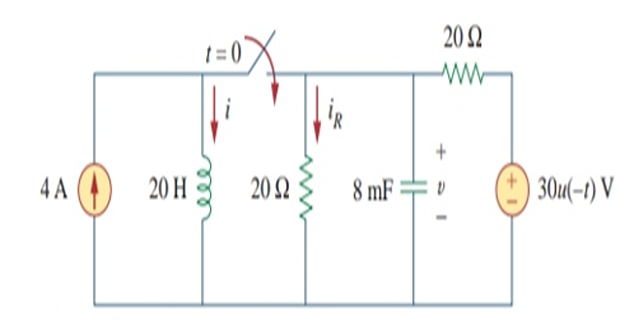
Solution-1
- \[i(0)=4 \mathrm{~A}\], the switch is open, and the circuit is partitioned into two independent subcircuits. The 4-A current flows through the inductor, so that For
- \[v(0)=\frac{20}{20+20}(30)=15 \mathrm{~V}\]resistor connected in parallel with it. By voltage division, the initial capacitor voltage is . The capacitor acts like an open circuit and the voltage across it is the same as the voltage across the , the voltage source is operative for and 0 when when Since
For \(t>0 \Rightarrow\) switch closed \(\Rightarrow\) parallel \(R L C\) circuit with current source.
The voltage source is zero which means it acts like a short-circuit.
The two \(20-\Omega\) resistors are in parallel to give \(R=20 \| 20=10 \Omega\).
- \[\begin{gathered} \alpha=\frac{1}{2 R C}=\frac{1}{2 \times 10 \times 8 \times 10^{-3}}=6.25 \\ \omega_{0}=\frac{1}{\sqrt{L C}}=\frac{1}{\sqrt{20 \times 8 \times 10^{-3}}}=2.5 \\ s_{1,2}=-\alpha \pm \sqrt{\alpha^{2}-\omega_{0}^{2}}=-6.25 \pm \sqrt{39.0625-6.25} \\ =-6.25 \pm 5.7282 \end{gathered}\]The characteristic roots are determined as follows:
or \(s_{1}=-11.978, \quad s_{2}=-0.5218\)
- \[i(t)=I_{s}+A_{1} e^{-11.978 t}+A_{2} e^{-0.5218 t} \cdots \cdots (1)\]\(i(t)\)\(I_{s}=4\), we have the overdamped case. Hence, Since
We now use the initial conditions to determine \(A_{1}\) and \(A_{2}\).
- \[i(0)=4=4+A_{1}+A_{2} \quad \Rightarrow \quad A_{2}=-A_{1} \cdots (2)\], At
- \[\frac{d i}{d t}=-11.978 A_{1} e^{-11.978 t}-0.5218 A_{2} e^{-0.5218 t}\]\[\frac{d i(0)}{d t}=-11.978 A_{1}-0.5218 A_{2} \cdots (3)\]\(t=0\) in Eq. (1), Taking the derivative of
- \[L \frac{d i(0)}{d t}=v(0)=15 \quad \Rightarrow \quad \frac{d i(0)}{d t}=\frac{15}{L}=\frac{15}{20}=0.75\]But
- \[0.75=(11.978-0.5218) A_{2} \Rightarrow A_{2}=0.0655\]Substituting this into Eq. (3) and incorporating Eq. (2), we get
Thus, \(A_{1}=-0.0655\) and \(A_{2}=0.0655 .\)
- \[i(t)=4+0.0655\left(e^{-0.5218 t}-e^{-11.978 t}\right) \mathrm{A}\]in Eq. (1) gives the complete solution as and Inserting
- \[i_{R}(t)=\frac{v(t)}{20}=\frac{L}{20} \frac{d i}{d t}=0.785 e^{-11.978 t}-0.0342 e^{-0.5218 t} \mathrm{~A}\]and , we obtain From
Problem-2
Determine \(v(t)\) for \(t>0\)?

Solution-2
Problem-3
Determine \(v(t)\) for \(t>0\)?
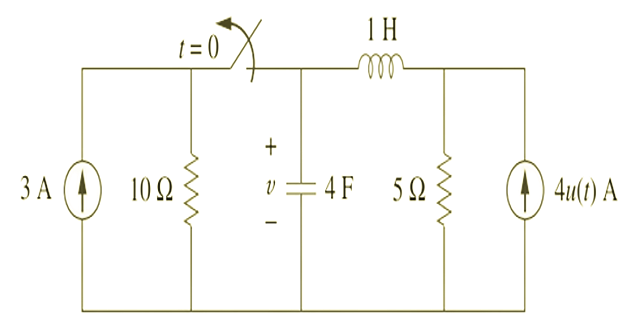
Solution-3
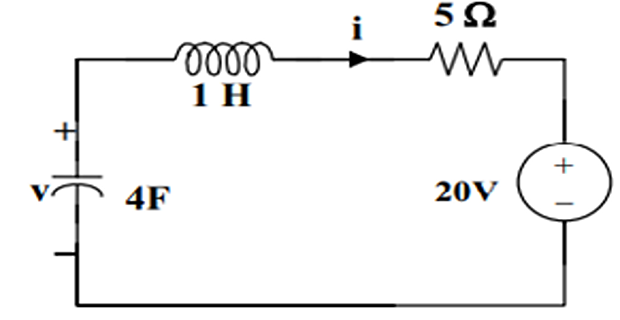
Problem-4
Determine \(i(t)\) for \(t>0\)?
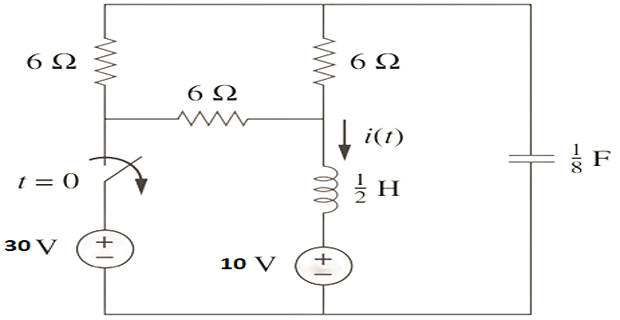
Solution-4
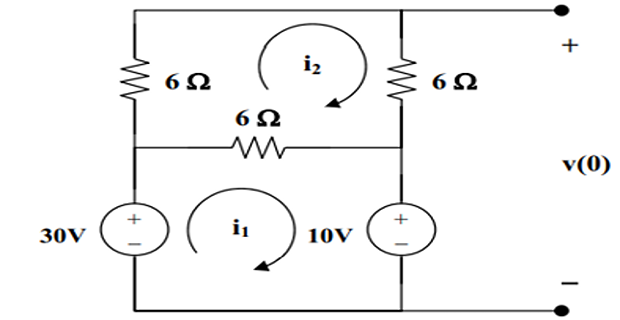
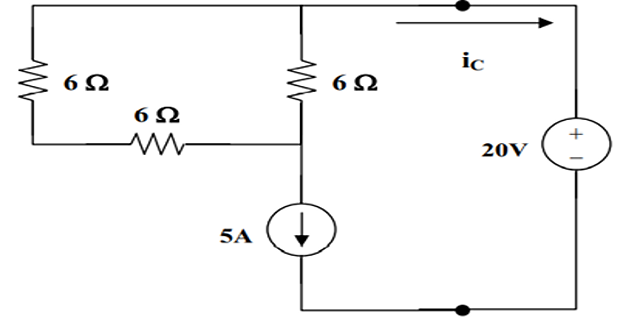
Problem-5
The switch is moved from \(a\) to \(b\) at \(t=0\). Determine \(i(t)\) for \(t>0\)?
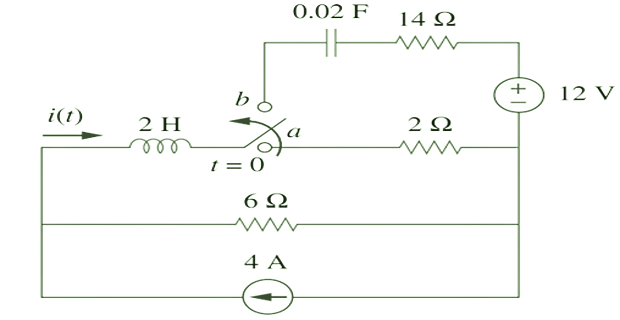
Solution-5
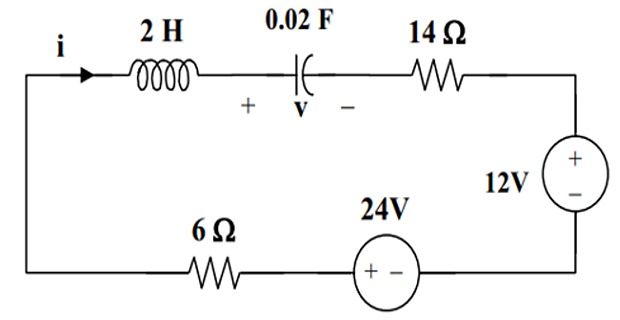
Since \(\alpha=\omega_{\mathrm{o}}\), critically damped response
Problem-6
Determine \(i(t)\) and \(v(t)\) for \(t>0\)?
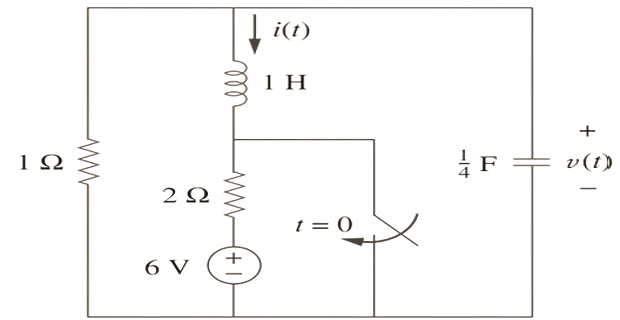
Solution-6
For \(t=0^{-} \Rightarrow i(0)=-6 /(1+2)=-2\) and \(v(0)=2 \times 1=2\)
- \[\begin{gathered} \alpha=1 /(2 \mathrm{RC})=(1) /(2 \times 1 \times 0.25)=2 \\ \omega_{0}=1 / \sqrt{\mathrm{LC}}=1 / \sqrt{1 \times 0.25}=2 \end{gathered}\], the voltage is SC For
- \[\mathrm{s}_{1,2}=-2\], Since
Problem-7
Determine \(i(t)\) for \(t>0\)?
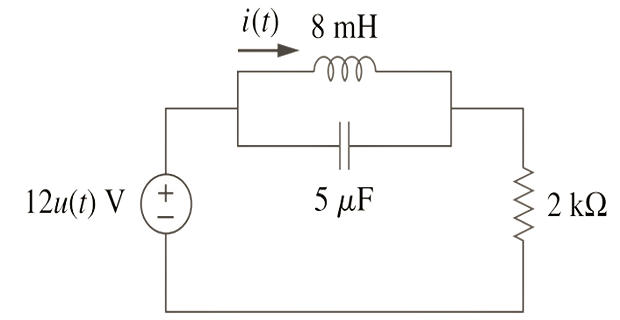
Solution-7
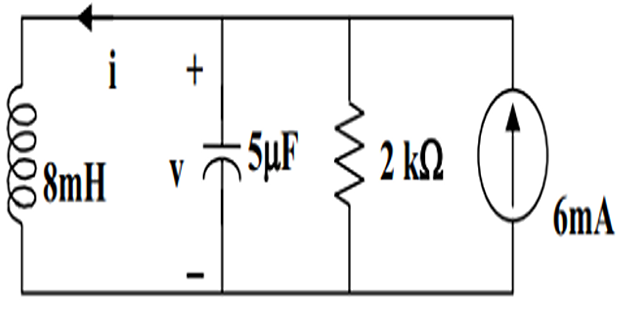
For \(t=0^{-}, u(t)=0\), so that \(v(0)=0\) and \(i(0)=0\).
- \[\begin{aligned} &\alpha=1 /(2 R C)=(1) /\left(2 \times 2 \times 10^{3} \times 5 \times 10^{-6}\right)=50 \\ &\omega_{0}=1 / \sqrt{L C}=1 / \sqrt{8 \times 10^{-3} \times 5 \times 10^{-6}}=5,000 \end{aligned}\], For
- \[\mathrm{s}_{1,2}=-\alpha \pm \sqrt{\alpha^{2}-\omega_{0}^{2}} \cong-50 \pm \mathrm{j} 5,000\], Since
Problem-8
Determine \(i(t)\) for \(t>0\)?
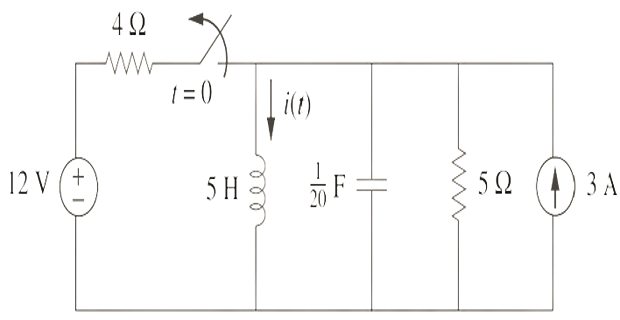
Solution-8
For \(\mathrm{t}=0^{-}, \mathrm{i}(0)=3+12 / 4=6\) and \(\mathrm{v}(0)=0\)
- \[\begin{gathered} \alpha=1 /(2 R C)=(1) /(2 \times 5 \times 0.05)=2 \\ \omega_{o}=1 / \sqrt{L C}=1 / \sqrt{5 \times 0.05}=2 \end{gathered}\], For
- \[\begin{gathered} \mathrm{s}_{1,2}=-2 \\ \mathrm{i}(\mathrm{t})=\mathrm{I}_{\mathrm{s}}+\left[(\mathrm{A}+\mathrm{Bt}) \mathrm{e}^{-2 \mathrm{t}}\right], \quad \mathrm{I}_{\mathrm{s}}=3 \\ \mathrm{i}(0)=6=3+\mathrm{A} \text { or } \mathrm{A}=3 \\ \mathrm{v}=\mathrm{Ldi} / \mathrm{dt} \text { or } \mathrm{v} / \mathrm{L}=\mathrm{di} / \mathrm{dt}=\left[\mathrm{Be}^{-2 \mathrm{t}}\right]+\left[-2(\mathrm{~A}+\mathrm{Bt}) \mathrm{e}^{-2 \mathrm{t}}\right] \\ \mathrm{v}(0) / \mathrm{L}=0=\mathrm{di}(0) / \mathrm{dt}=\mathrm{B}-2 \times 3 \text { or } \mathrm{B}=6\\ \mathrm{i}(\mathrm{t})=\left\{3+\left[(3+6 \mathrm{t}) \mathrm{e}^{-2 \mathrm{t}}\right]\right\} \mathrm{A} \end{gathered}\], Since
Problem-9
Determine \(i(t)\) for \(t>0\)?
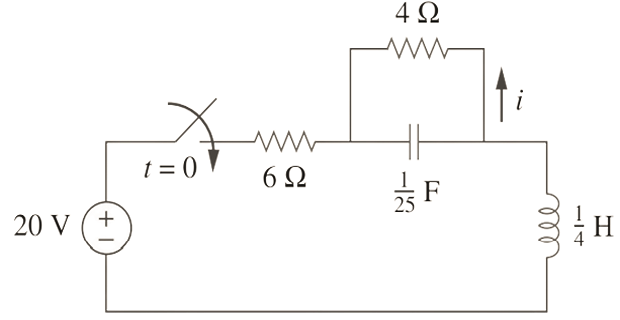
Solution-9
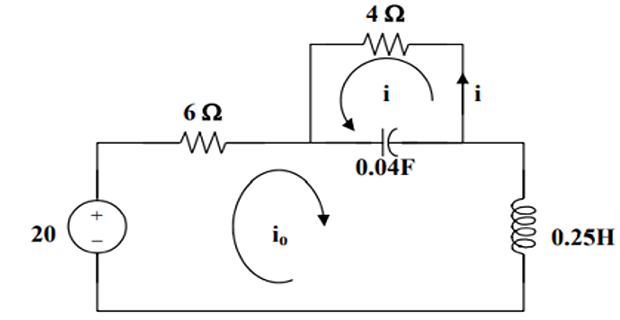
KVL in larger loop, \(-20+6 \mathrm{i}_{0}+0.25 \mathrm{di}_{0} / \mathrm{dt}+25 \int\left(\mathrm{i}_{0}+\mathrm{i}\right) \mathrm{dt}=0 \cdots (1)\)
smaller loop, \(\quad 4 \mathrm{i}+25 \int\left(\mathrm{i}+\mathrm{i}_{\mathrm{o}}\right) \mathrm{dt}=0\) or \(\int\left(\mathrm{i}+\mathrm{i}_{\mathrm{o}}\right) \mathrm{dt}=-0.16 \mathrm{i} \cdots (2)\)
Taking derivative, \(\quad 4 \mathrm{di} / \mathrm{dt}+25\left(\mathrm{i}+\mathrm{i}_{0}\right)=0 \Rightarrow \mathrm{i}_{0}=-0.16 \mathrm{di} / \mathrm{dt}-\mathrm{i} \cdots (3)\)
And \(\mathrm{di}_{0} / \mathrm{dt}=0.16 \mathrm{~d}^{2} \mathrm{i} / \mathrm{dt}^{2}-\mathrm{di} / \mathrm{dt} \cdots (4)\)
From (1), (2), (3), and (4), \(\quad-20-0.96 \mathrm{di} / \mathrm{dt}-6 \mathrm{i}-0.04 \mathrm{~d}^{2} \mathrm{i} / \mathrm{dt}^{2}-0.25 \mathrm{di} / \mathrm{dt}-4 \mathrm{i}=0\)
Which becomes, \(\quad \mathrm{d}^{2} \mathrm{i} / \mathrm{dt}^{2}+30.25 \mathrm{di} / \mathrm{dt}+250 \mathrm{i}=-500\)
This leads to, \(s^{2}+30.25 s+250=0\) or \(s_{1,2}=\frac{-30.25 \pm \sqrt{(30.25)^{2}-1000}}{2}=-15.125 \pm \mathrm{j} 4.608\) underdamped
Thus, \(\mathrm{i}(\mathrm{t})=\mathrm{I}_{\mathrm{s}}+\mathrm{e}^{-15.125 \mathrm{t}}\left(\mathrm{A}_{1} \cos (4.608 \mathrm{t})+\mathrm{A}_{2} \sin (4.608 \mathrm{t})\right) \mathrm{A}\)
At \(\mathrm{t}=0, \mathrm{i}_{\mathrm{o}}(0)=0\) and \(\mathrm{i}(0)=0=\mathrm{I}_{\mathrm{s}}+\mathrm{A}_{1}\) or \(\mathrm{A}_{1}=-\mathrm{I}_{\mathrm{s}}\).
As \(\mathrm{t} \rightarrow \infty\), \(\mathrm{i}_{\mathrm{o}}(\infty)=\) \(20 / 10=2 \mathrm{~A}=-\mathrm{i}(\infty)\) or \(\mathrm{i}(\infty)=-2 \mathrm{~A}=\mathrm{I}_{\mathrm{s}}\) and \(\mathrm{A}_{1}=2\).
From (3), \(\operatorname{di}(0) / \mathrm{dt}=-6.25 \mathrm{i}_{\mathrm{o}}(0)-6.25 \mathrm{i}(0)=0\). \(\mathrm{di} / \mathrm{dt}=0-15.125 \mathrm{e}^{-15.125 \mathrm{t}}\left(\mathrm{A}_{1} \cos (4.608 \mathrm{t})+\mathrm{A}_{2} \sin (4.608 \mathrm{t})\right)+\mathrm{e}^{-15.125 \mathrm{t}}\left(-\mathrm{A}_{1} 4.608 \sin (4.608 \mathrm{t})\right.\) \(\left.+\mathrm{A}_{2} 4.608 \cos (4.608 \mathrm{t})\right)\) .
- \[\begin{aligned} \operatorname{di}(0) / \mathrm{dt}&=0=-15.125 \mathrm{~A}_{1}+4.608 \mathrm{~A}_{2}=-30.25+4.608 \mathrm{~A}_{2}\\ \text{or} & \mathrm{A}_{2}=30.25 / 4.608=6.565 \end{aligned}\], At
- \[\mathrm{i}(\mathrm{t})=\underline{\left(-2+\mathrm{e}^{-15.125 \mathrm{t}}(2 \cos (4.608 \mathrm{t})+6.565 \sin (4.608 \mathrm{t})) A\right.}\]This leads to,
Problem-10
The switch has been closed for a long time and then opened at \(t=0\). Determine \(i_x\) and \(v_R\) for \(t>0\).
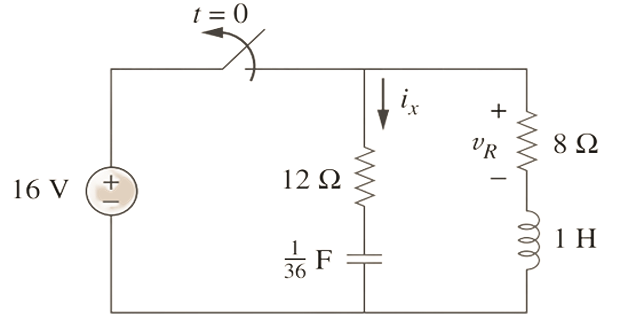
Solution-10
Let \(\mathrm{v}=\) capacitor voltage and \(\mathrm{i}=\) inductor current.
- \[\mathrm{v}(0-)=16 \mathrm{~V} \text { and } \mathrm{i}(0-)=16 / 8=2 \mathrm{~A}\]switch is closed and circuit has reached steady-state. At
At \(\mathrm{t}=0+\), the switch is open but, \(\mathrm{v}(0+)=16\) and \(\mathrm{i}(0+)=2\).
- \[\begin{gathered} \mathrm{R} = 8+12=20 \Omega, \mathrm{L}=1 \mathrm{H}, \mathrm{C}=4 \mathrm{mF} . \\ \alpha=\mathrm{R} /(2 \mathrm{~L})=(20) /(2 \mathrm{x} 1)=10 \\ \omega_{\mathrm{o}}=1 / \sqrt{\mathrm{LC}}=1 / \sqrt{1 \times(1 / 36)}=6 \end{gathered}\]We now have a
- \[\mathrm{s}_{1,2}=-\alpha \pm \sqrt{\alpha^{2}-\omega_{0}^{2}}=-18,-2\], Since
Characteristic equation is \((\mathrm{s}+2)(\mathrm{s}+18)=0\) or \(\underline{\mathbf{s}^{2}+\mathbf{2 0 s}+\mathbf{3 6}=\mathbf{0}}\).
\(\mathrm{i}(\mathrm{t})=\left[\mathrm{Ae}^{-2 \mathrm{t}}+\mathrm{Be}^{-18 \mathrm{t}}\right]\) and \(\mathrm{i}(0)=2=\mathrm{A}+\mathrm{B} \cdots (1)\)
To get \(\operatorname{di}(0) / \mathrm{dt}\), consider the circuit below at \(\mathrm{t}=0+\).